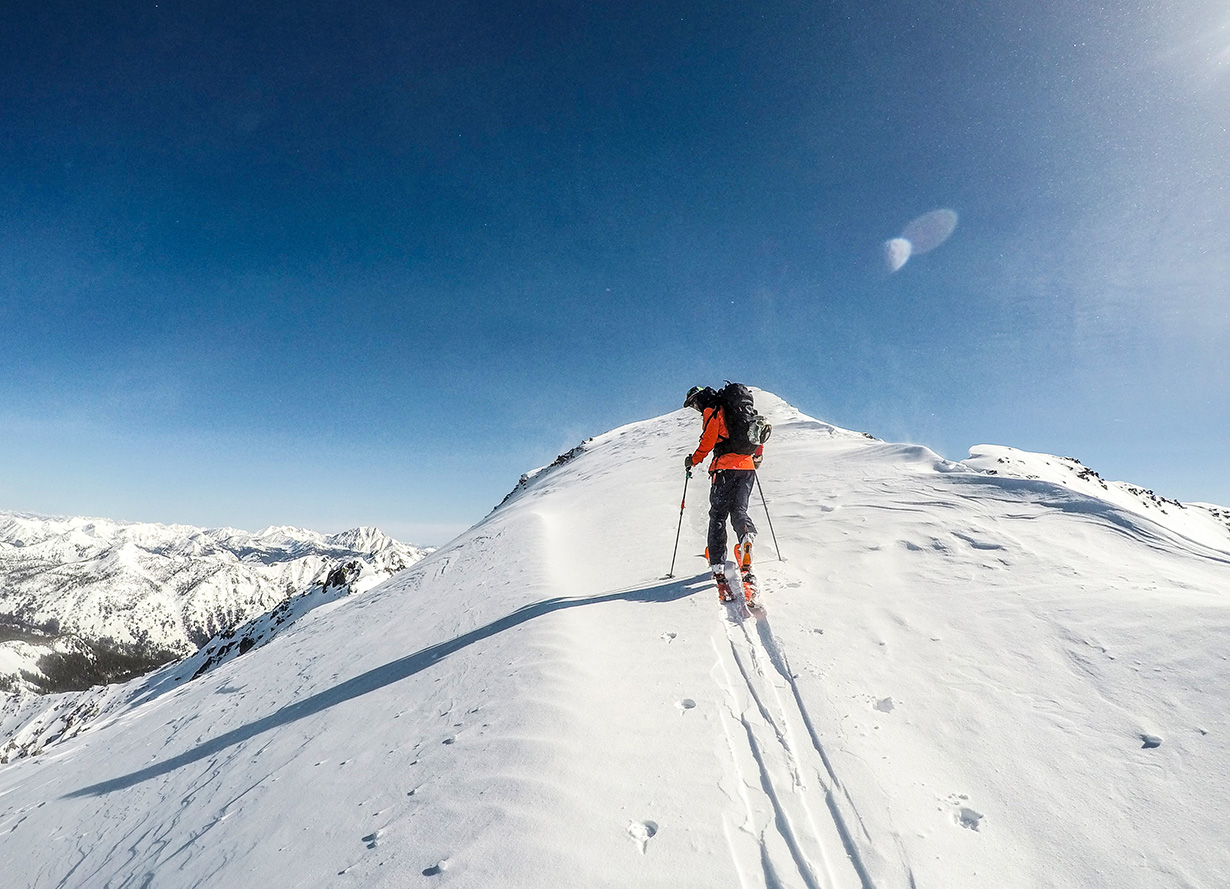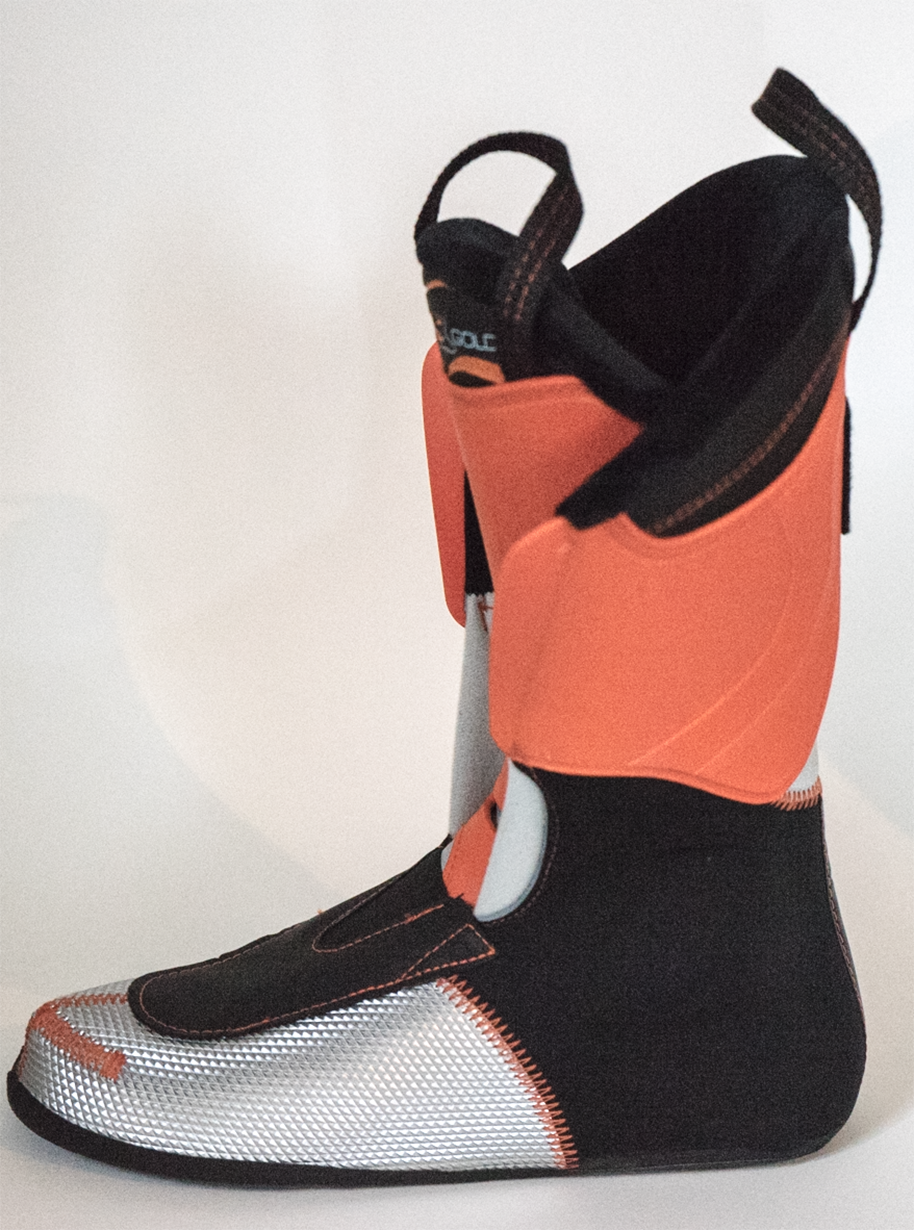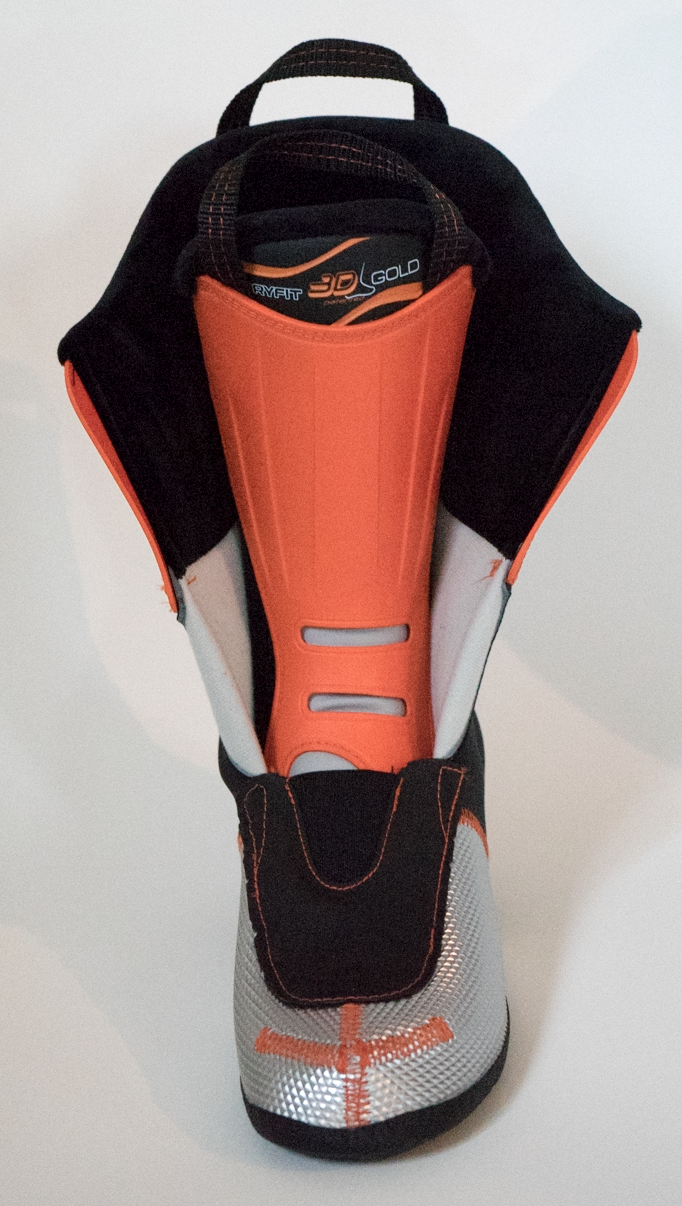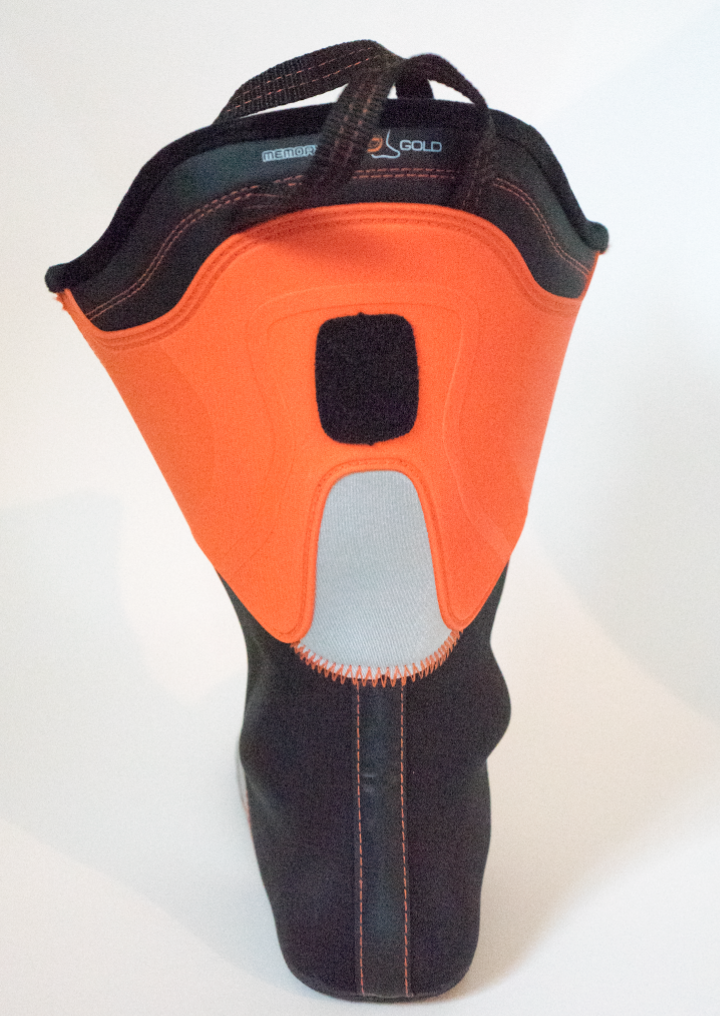Touring
With the cuff unbuckled and the walk mode open, the Hawx Ultra XTD 120 walks very, very well. Its ROM feels smoother and bigger than the Salomon MTN Explore and La Sportiva Spectre 2.0. My strides felt smoother and more natural in the XTD 120 than they have in any other comparable boot I’ve been in. It’s no ultra-light boot in terms of ROM (which is why boots like the Atomic Backland, Salomon X-Alp, and Dynafit TLT6 exist), but the touring feel of the boot is much more reminiscent of those options than are boots like the Salomon MTN Lab or Nordica Strider.

And it helps that this is also a relatively light boot. I did a few bigger days on the Ultra XTD 120, and was very happy with how little fatigue my legs and ankles experienced. The walk mode is solid and easy to actuate, and the boot walks very well. There’s really not much more you could ask for from a 120-flex boot on the way up. The heavier, stiffer, production liner may change this a bit, and I’ll update once I’ve spent time in it.
Downhill Performance
Given how well the Ultra XTD 120 walked, I tried to downplay my expectations for how well the Ultra XTD 120 would ski. But I shouldn’t have. Even with the lighter, more touring-oriented liner, they skied very well. I was impressed by the lateral support, I never felt unstable, and I never felt the shell deforming, even when skittering around on some very firm snow on Galena Peak. I think Atomic is justified in calling this a “120-flex” boot. So far, it certainly feels like more boot than the Salomon MTN Explore, La Sportiva Spectre 2.0, and even the Roxa R3 130.
As you’d expect, the forward flex of the XTD 120 isn’t as progressive or forgiving as that of a good alpine boot; it ramps up very quickly, and can feel a little harsh. But I found it to be more progressive, consistent, and stable than the flex of the MTN Explore, La Sportiva Spectre 2.0 or Roxa R3 130.
I’m really excited to ski the Hawx Ultra XTD 120 with the production liner since it should make the flex of the boot feel even stiffer, more padded, and more forgiving. With the XTD 130’s lighter liner, I’d be happy skiing the Hawx Ultra XTD 120 inbounds from time to time in any conditions, but I wouldn’t want to make it my everyday boot; it’s just not damp and substantial enough. So it will be interesting to see how the heavier liner changes this. But even with the lighter, Pro Tour-style liner, the boot feels plenty strong for anything I’d expect to encounter in the backcountry.
Who’s It For?
Before skiing the XTD 120’s production liner, this is a hard question to answer definitively. With the lighter liner I’ve skied, I’d recommend the Hawx Ultra XTD 120 to a wide range of skiers. It’s light and walks well enough to appeal to people looking to log long days with lots of vert, but it skis well enough that those looking to ski bigger lines fast or jump off of things in the backcountry should give it a look. For skiers looking for an even stiffer, lighter option, the XTD 130 should be considered. But with its new liner, the XTD 120 could be more attractive to those looking for a lightweight 50/50 boot, and it will be interesting to see how its ROM is affected.
As a skier who likes to go on long, exploratory tours, I’ve been very happy with the XTD 120’s weight, ROM, and excellent fit. I did my longest “we’re not really lost, but we don’t know where we are and we’re a long way from the car and it’s almost dark” tour of the season in the XTD 120, and was very happy with the boot. It made walking easy, and didn’t hurt at all — even when a short after-work lap turned into something a lot more strenuous.
And as a skier who also likes to tour to find fresh snow to jump off of things, the Ultra XTD 120 also checks a lot of boxes. It skis well above its weight class, and I’m excited to see how well it can drive some bigger skis (like the Moment Bibby Tour) and handle pillowed, cliffy terrain.
Update (6.28.17) — Hawx Ultra XTD 120 Liner Update
We just received the production liners for the XTD 120, so we’ve updated our weights at the top of the review, added photos, and have more details.

The production liner adds about 155 g per foot over the XTD 130 liners I’d been skiing in previously. That means the XTD 120 is not quite as competitive weight-wise with boots like the Salomon MTN Explore, but the production XTD 120 liner fits and makes the XTD 120 boot feel much more like a true alpine boot.

The heel pocket feels more secure, and my calf and shin feel much more locked in and supported than with the XTD 130 liner I had used with the boot. While I haven’t yet been able to get on snow in the production XTD 120 liner, just trying the boot on and flexing it at home, the liner feels a lot stiffer and more secure. That’s saying quite a bit, since this was already the stiffest, most downhill-oriented liner of the 110-120 flex touring boots I’ve been in this season.

The new XTD 120 stock liner really does justify the XTD 120’s WTR soles (which make the boot compatible with WTR alpine bindings), and I’m excited to see how it performs in challenging, inbounds conditions.
That said, the new XTD 120 liner does have a bit of a negative impact on the XTD 120’s range of motion. The heel cutout on the liner is not as flexible, and the tongue is stiffer. When used with the (lighter, more touring-oriented) Hawx Ultra XTD 130 liner, the Hawx XTD 120 was the best-walking touring boot in this class that I’ve used, by a healthy margin.
With its new stock liner, the range of motion isn’t quite as great; it feels just a little better than the Salomon MTN Explore. That’s not to say that its ROM is bad at all — it’s still very impressive. But it’s not quite the jazz-walking slipper it was with the softer, lighter liner of the XTD 130.
So what are the takeaways here?
With this new stiffer, more inbounds-oriented liner, the Hawx Ultra XTD 120 should be a pretty capable boot in variable conditions.
But what if you want to go on long tours and don’t mind giving up some of that downhill performance?
You have two options:
(1) You can buy the XTD 130 instead, and get a stiffer shell with a lighter liner. Or…
(2) You could buy a pair of Intuition Pro Tours (or another similar liner) for the XTD 120, and swap out the liner depending on whether you’re skiing inbounds or going on a ski tour.
Personally, I’m more intrigued by that last option. It would be great if we could all have a quiver of touring boots that ranged across the entire performance spectrum, but short of that, it might make more sense — and cost less money — to own a quiver of liners.
The Hawx Ultra XTD 120 shell is truly impressive — it has a huge range of motion, and it skis very well. But it’s hard to make a liner that shines both on the ascent and on the descent; liners that walk really well generally don’t ski very well, and vice versa. So I can imagine a lot of scenarios where just owning the XTD 120 shell (with its burlier stock liners) and also a pair of lighter liners would make a lot of sense.
Say you’re doing a long, all-day tour but are going to be skiing lines where you want a hefty boot. Just throw your lighter liners in the XTD 120, and you’re good to go for 8 hours of touring and skiing. Then the next day, when you want to go ski a few short sidecountry laps of pillows and cliffs, slip the heavier, stiffer stock liners back in.
Or say you’re traveling and don’t want to carry two pairs of boots. With two liners and the XTD 120 shell, you would be fully prepared for anything from a multi-day hut trip to several days of inbounds skiing.
That’s all conjecture of course for now, but I’m really, really excited to try the XTD 120’s with its stiffer stock liners and test this theory.
NEXT: Performance Update + Comparisons

So when does this baby hit the shelves?
3rd option – buy 130 and use more alpine style liner on inbound days!
I currently own the Hawx Ultra 130 alpine boot and love them! Do you think I could buy the Hawx Ultra XTD 130 and swap liners as your suggesting for the best of both worlds? Do you think that could work?
The short answer is Yes, John, it could definitely work.
There’s no guarantee once you start switching liners and shells that the result will be perfect for *your* particular feet. But I know people who have done exactly what you are asking about, and they’ve gotten great results. So it is most definitely worth a try.
If you go this route, please let us know how it goes!
So glad to see reviews of both the 120 and 130 here! I’m a little more inclined to go with the 120 for the flex characteristics of the shell, and looks like the shell weights between the 120 and 130 are near-negligible.
Sounds like the design is great and solid, but is there anything you see getting changed after the first production year?
I want a very downhill oriented, but light touring boot (and I have very narrow foot), so the 130 Hawx XTD seems perfect. But when I tried them on, the flex didn’t seem very progressive and I found the end of the flex. The liner of the 120 XTD seems to be more up my alley. Any way that you know of to get the 130 Hawx XTD shell but with the 120 Hawx XTD liner?
Also, is the 130 Hawx liner the same as the 120 Hawx XTD liner?
Thanks!
Intuition and others sell aftermarket liners, so you could get one from them in the style you desire. (For example if you have skinny ankles like me, the alpine wrap liners will add a lot of stiffenness and shock absorption).
Hi all…. so I am deciding between Atomic and Roxa. I am a female who does not “charge” or muscle my way but finesse my way through my turns in the back country or in resort. These days I ski 60% in bounds and do 1/2 – 3/4 days in the back country. Will be moving to more back country days this winter. Ideally want ONE boot to do both.
Thank you in advance!
How much stiffer is the 130 with the same liner?
As a big guy 6’3″ 200lbs who skis 80% BC I am leaning towards the 130 and picking up a set of inbounds liners at some point, does that seem like a reasonable approach or could I get away with the 120?
This is a great review. It is quite likely I will purchase your recommended setup. One caveat I read is that the sole is non replaceable. Is this an issue? I tend to wear the soles out long before the boot. Thanks!
@CyWhitling & @JonathanEllsworth – Seriously scratching my head: why on earth would Atomic spec their *second* stiffest 120-flex touring boot w/ a stiffer liner than the 130 version? You guys take that decision in stride, but it makes zero sense to me: if I want a beefier shell, I want a liner substantial enough that I can comfortably drive it. Am I missing something here?
Any thoughts on the 100-flex boot? Do you know if the liner is similar?
Not sure I need/can handle a 120-flex boot (my own Salomon Quest Max 130 are killing me – too stiff)!
How would you compare this boot to the new scarpa mastrale, both in terms of uphill and downhill performance, and in terms of the 130 liner vs production liner. Thanks!
Really enjoyed this review, and at the store I really liked the feel of the 120 liner, but….I have to say I’m puzzled about these boots….I used the XTD 120 with the 120 liner for a light touring day, about 16km or 10 miles on fairly gentle terrain (this was my second time out, first time was a short day on piste and enjoyed their flex/stiffness level on easy and expert icy runs. Flowing this we added some padding to the liner however to help keep it more in place, as the heel pocket didn’t feel solid). On the way up touring, after an hour, I could feel blisters developing. I stopped to protect the areas. In the cold, I found it very, very difficult to take the boots out and put them back on. By the end of the day, I had about 6 blisters and two broken toe nails. One toe is swollen, black and now infected. Ironically, I never felt a ‘hitting’ type pressure in the front! The store wants to try another heat mold, I suppose expand it, but wonder if this boot is really meant to primarily ski in the resort, going down, or if it can be used as a real touring uphill boot…or maybe it’s just not right for my feet, I do have ‘difficult’ wide feet…or maybe I’m doing something else wrong. Any thoughts if after such damage I should even consider another try? Should I replace the liner? (5 days later I still limp, can only wear running shoes, and still can’t feel the top of my now dark red, black and white toe…and no, doc says it’s not a frost bite).
Replying to the old post late – but maybe it will help others. Ultra is Atomic’s range from narrow feet. What you probably want is Prime XTD (unfortunately they dont make wide foot model Magna for touring).
Hello,
How would you compare the downhill performance of this against the Salomon QST Pro 130? I just bought the Blister Winter Guide, and there Salomon has been placed to the Alpine / Touring category, and Atomic to the touring category. I am quite lightweight skier (72kg, 177cm), and doesn’t ski aggressively. I ski around 50/50 inbound and off-piste, but as I am skinning up only 5% of total time, the downhill performance counts more. Atomic is way better in other ways than Salomon, but if it is much worse in downhill, then I will probably have to head for the Salomon.
Hello!
Just curious … what’s your street shoe size? Thanks!
What would you recommend between this and the Lange Free Tour 130, assuming they both fit me?
I probably ski 50/50 resort and touring, but have a couple of bigger multi day touring trips planned.
I’m after a one boot quiver.
Just wondering if you guys have run into any issues using the hawx xtd boot with STH2 16 WTR bindings – I just mounted some skis with them and it doesn’t seem like there is enough toe height adjustment to create the necessary 0.5mm gap between the boot sole and afd pad… but both the boot and binding are labelled “wtr” so they should work. I’ve contacted atomic and haven’t heard anything, but i’m curious if my experience is isolated or if you guys have run into something similar.
Did you ever hear anything about this? I have the same issue with the Marker Jester ID. Not enough toe height for mounting. These are fine for my touring skis but looking for something on my resort skis.
The 2019 XTD has a WTR sole. Only bindings that are WTR compatible – e.g. Salomon Warden that has enough front toe adjustment. Unfortunately, my experience with Marker bindings has been really bad. The Marker Jester ID does not work with WTR. It’s a pretty screwed situation. I had to replace 3 pairs of Marker bindings because of this and Marker was less than helpful or even forthcoming about the situation. The entire WTR / Gripwalk standard thing has been a complete cluster. Don’t quote me on this, but my understanding is that Marker / Dalbello’s GripWalk standard won out and next years boots will mostly be migrating to Gripwalk. e.g. The 2020 Atomic XTD 130 has a GripWalk sole.
I have a couple of pairs of Salomon STH2 13 WTR bindings and have the same issue with the toe not adjusting as high as it should for my Hawx XTD’s. If you put some rearward pressure on the boot, there will be a slight gap, so I decided to just use them. I did have instance where I hit a chunk of ice at high speed and the binding released like it should. So I think its not ideal but workable.
Great review. I recently tried on a bunch of boots, and I really liked the feel of the Atomic Hawx 120. The size 29.5 felt good, much tighter than the generally loose and sloppy boots I am used to, but surprisingly comfortable. Except in two places. Over my prominent bunions (metatarsal bump?) and in front of my big toe. Standing up straight, my toe crunches against the front of the liner. Moderately flexing the boot, my big toe does not touch the front of the boot. Other than that…great fit? My questions:
1) How much can I expect the Atomic memory fit to stretch? By baking the shells and liners, can I expect to gain appreciable width? What about length? Can the memory fit process make the boots longer, if only a little bit?
2) If the memory fit process can not make the boots longer, is there any way to do a punch just for my big toe? I expect a punch on the side of the boot for my bunion would be no problem, but what about right at the front of the boot?
Advice appreciated….
As always, great rewievs. Is about to buy new boots and due to kids I doesnt want several boots, no place and all money goes to the kids snowboard addiction :). Do want a boot for most downhill (inbounds groomers) use but do want to be able to tour with it. Have tried every boot existing and the only one that really fits my feet (an seriously it fits like nothing like I experienced before, so good) is the Atomic hawx Xtd 120. But after reading blisters review and buyers guide where you place the the XTD (even the 120) as a pure touring boot I get really hesitant.
in what sense do you think the alternatives from Lange (,XT freetour) Head (Kore), Technica (cochise) etc would work better then the XTD 120 for downhill use? just standing in a shop its really hard to say anything about flex when atomics truflex makes the boots behave much like it would when its cold and langes or Technicas feels really soft forward flex wise
I also wonder if Atomic have made changes to the 120 version as the stated weight is 200g heavier then the version blister made the review on.
I like the idea with the Intuition Pro Tour Liner. Which volume version (I assume medium or high) should I take if the stock liner from the xtd120 fits me perfect?
late reply, but mayb help others.. check the fitting guide on intuition website. you need to measure your shell fit without a liner and decide based on that. i barely fit a finger behind my heel – so i went for LV (liners on the way :) i read reviews where people went one volume up to have tighter fit only to find out it is too tight.
Just happened to crack the upper boot piece close to the inner ankle pivot
You guys think this is normal after skiing approx 60 days in these boots
I absolutely love the performance of my Hawx XTD 120 boots but find them almost impossible to get my foot into them past the arch unless they are warmed up next to a heater before attempting to put them on. I actually bought a heated boot bag to keep them pliable enough during the drive to the trailhead. Has anyone else noticed this? Any tips?
yup, the same here – the shell bend above the instep is just too tightly bent and overlap is rather short, so if tongue gets out of the overlap, the bend keeps its sharp shape, presses on your instep and it really hurts.
the only thing that works when i forget to keep them in the heated bag is to push my foot as far as it goes, then kneel down on the other knee, put my hands under the outer cuff flaps, open them with the back of my hands and use fingers to pull overlapping shell top parts apart until my foot slips in.